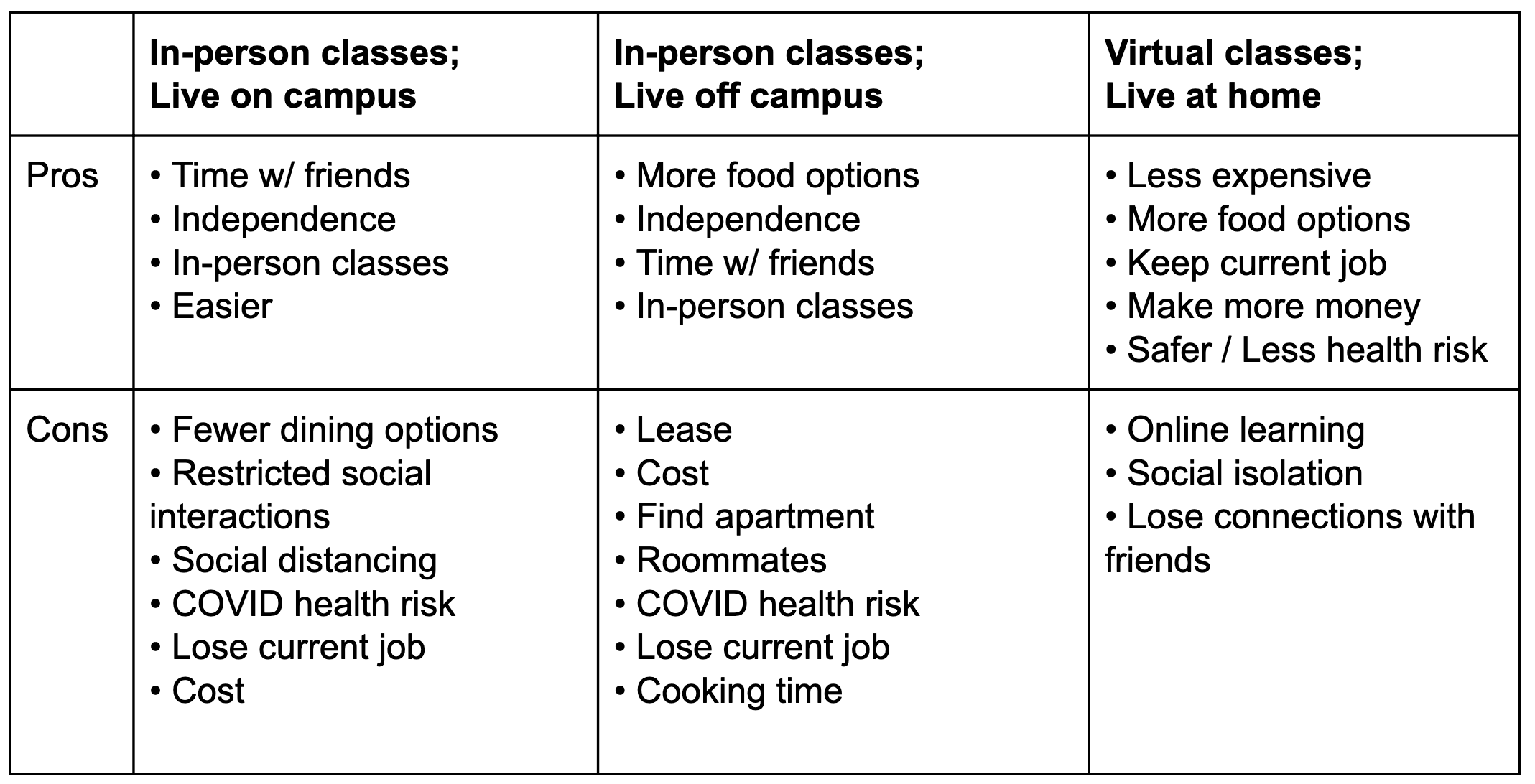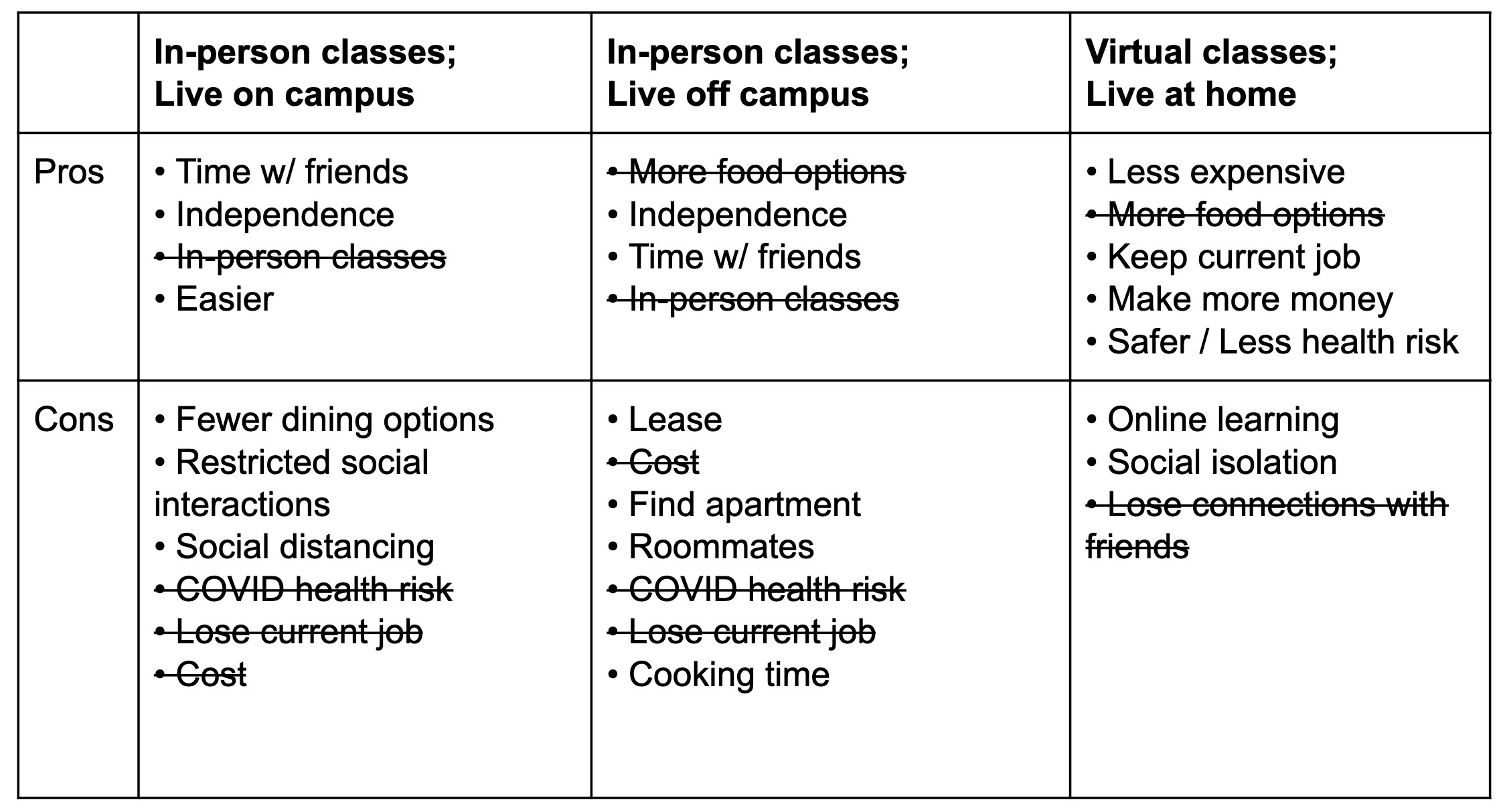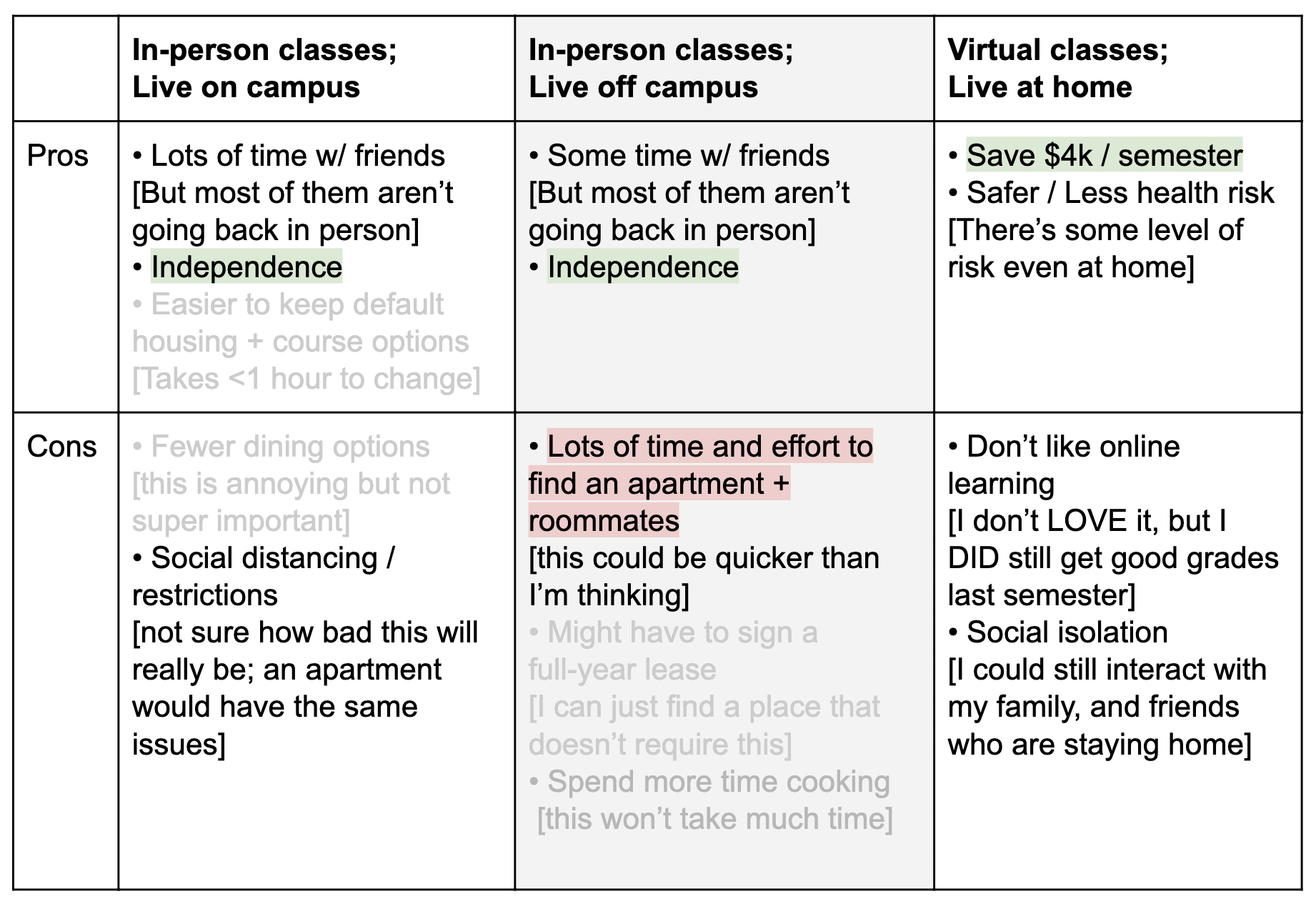Students this fall are facing some hard choices…
- Should they return to class in person or virtually?
- If they’re in college, is it still safe to live on campus? Or should they live off-campus and commute?
- Should they consider taking a gap year or semester off if all their classes are online?
When the stakes feel so high, how can students make informed decisions that feel right?
If there’s anything we’ve learned from deciding how to head back-to-school in the face of a pandemic, it’s that making big decisions like this is really hard.
Over the past six months, we’ve all been forced to make some difficult decisions…and we’re going to continue having tough choices to make moving forward. (What will they do if online learning isn’t working for them this Fall? How will they respond if their school shuts down and moves online?)
So, it’s important to make sure our students are prepared with good decision making skills so that they can navigate this uncertain year as effectively as possible, and make the best decisions they can with the information they have available to them.
The first step in making a hard decision, especially in uncertain situations, is asking the right questions so you can find out as much information as possible about the available options.
But without a way to sort through and integrate this information, it’s easy to either…
- Jump to conclusions without considering all of the facts, OR
- Try to take so many of the facts into account that you end up overwhelmed, second guessing yourself, and getting stuck in indecision
As a recovering perfectionist myself, I know how frustrating it is to get stuck on the fence, uncertain which option to choose… and wishing I had a crystal ball and could just KNOW for sure which one would lead to the best outcome.
So, over time, I’ve developed a decision-making process that helps me sort through all of the available information so I can make an informed choice about which option is going to lead to the best outcome.
This approach continues to help me through difficult decisions in my own life, and I’ve found it to be helpful for a lot of our students as well.
Here’s an overview of how it works:
1. Identify your options.
This sounds like a simple step, but you’d be surprised how many times students get stuck with their decision-making because they are trying to choose between two sub-optimal options…when there is a third, fourth, or fifth option they haven’t considered that could lead to a much better outcome.
For example, a lot of college students this semester felt like they only had two options to choose from: (1) go back to campus and take classes in person, OR (2) stay at home and take classes online. But when they thought through the situation carefully, they realized there were actually many more available options, including…
- Take in-person classes; live on campus
- Take in-person classes; live in an apartment off campus
- Take in-person classes; commute from home
- Take online classes; live on campus
- Take online classes; live at home
- Take online classes; live in an apartment off-campus
- Take online classes; get an apartment in a less-expensive part of town that’s farther away from campus
- Take classes as a transient student at a different college; live at home
- Take a semester off from college and get a full-time job to earn extra income
…and some students were able to come up with even more possibilities!
In most situations, there will be more options available than you initially thought, and having more choices on the table can make it easier to find one that works for you. So, before exploring the pros and cons, make sure you’ve put some effort into brainstorming ALL of your options.
2. Outline the pros and cons.
Think through each of the options you are considering and outline all the pros and cons you can think of for each of them. To make it easier to keep track of this information, consider arranging it in a table so it’s easy to see the pros and cons associated with each option.
For example, here is a simplified version of a decision-making table for a student trying to choose between three possible options for Fall semester classes:

3. Eliminate duplicates.
Part of what makes it challenging to make good decisions is that there are so many different factors to consider, and trying to take all of them into account can feel overwhelming. Eliminating duplicate information can help simplify this process and make it easier to see what is truly different about the available options. So, before moving forward with the decision-making process, make sure you’ve eliminated duplicate information.
For example, in the chart below, “limited dining options” is listed as a CON for on-campus housing, and a PRO for options that are off campus. To eliminate duplicates, consider where this factor really belongs — is it more of a CON to have limited dining options available on campus, or more of a PRO to have more options available off campus? If the REAL problem is that the lack of options on campus bothers you, leave it as a CON in that column and cross it off the PROS list for the other two options.
This same approach can help to eliminate other duplicate factors in the chart, including health risks, online learning vs. in-person classes, time with friends, cost, and losing their current (summer) job:

4. Get specific.
Make sure the wording you are using for each option clarifies EXACTLY what you mean by each pro and con. For example, in the chart below, “easier” can be expanded to what it really means – “Easier to keep default housing + course options”.
While getting specific, you will realize that some pros or cons you have listed are actually the same and can be combined into one factor. For example, in the chart below, two CONS of living on campus – “social distancing” and “reduced social interactions” – are effectively the same thing and can be combined into one option. Similarly, three of the pros of living at home relate to making and/or saving money and can be combined into one factor (“save money”). You can also add an estimate of how *much* money you would be likely to save by eliminating housing costs

5. Play devil’s advocate.
Not all of the factors you have listed are going to be equally important; some will matter much more than others. To identify the less important factors, play devil’s advocate by trying to come up with reasons why each factor on the list doesn’t matter very much and shouldn’t impact your decision.
For example, in the chart below, you might argue that “Easier to keep default housing + course options” doesn’t really matter because it will take less than an hour to change; this isn’t going to have a big impact on your life. It IS still a factor, but shouldn’t play a big role in your decision-making and can be safely greyed out.

6. Highlight the factors that matter most.
To help visually identify the MOST important factors in your decision-making, you can highlight the pros and cons that matter most to you. This will help narrow your focus to the few true essential factors that really matter for your decision.
For example, in the chart below, living on campus looks like it is a better option than living off campus because the pros are the same but off-campus housing is more logistically complicated. So, that option can be safely eliminated.
Just looking at the highlighted factors, you can compare in-person vs. virtual classes by asking yourself “Is it worth $4k/semester to have more independence?”

Taking the time to walk through all of these steps can be time-consuming and isn’t necessary for every decision you make. But for BIG decisions that REALLY matter, taking the time to go through these steps will ensure students actually understand the pros and cons of the options available to them, and makes sure they’re not acting on incomplete information.
I hope this helps take a little pressure and confusion out of deciding what to do this fall! I’d love to know if you or your teen have any other methods of making difficult decisions.

Join 11,000+ parents helping their students earn better grades with less stress!

About The Author
Dr. Maggie Wray is a certified ADHD Coach & Academic Life Coach with a Ph.D. in Neurobiology and Behavior from Cornell and a Bachelor’s degree in Astrophysics from Princeton. She founded Creating Positive Futures in 2012 to help high school and college students learn how to earn better grades with less stress. Her team of dedicated coaches is on a mission to empower students to develop the mindset, organization, time management, and study skills they need to achieve their goals.
Related Posts
Other Posts You May Enjoy
Preparing for exams: 4 steps to success
As we get closer to exams, students are getting increasingly stressed out. And when teens are stressed about their exams, it can affect everyone else around them, too! Following the four-step planning process below can help students prepare more effectively for their...
How to finish the semester strong
Students' grades are the most important factor colleges consider when making admissions decisions.So, with the end of the semester approaching, how can you make sure your student is finishing the semester with the best grades they can? At this point in the semester,...
Why it’s hard for students to “just turn in” missing assignments, and how to get them unstuck
With the end of the semester on the horizon, many students may feel overwhelmed by low grades or feeling behind in some of their classes. As a parent, it can be stressful to see that your student has overdue work, or get notifications from their teacher that they’re...




